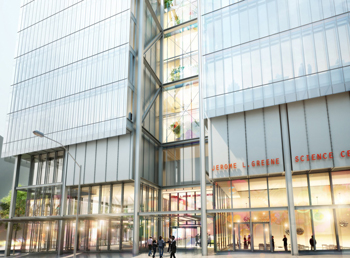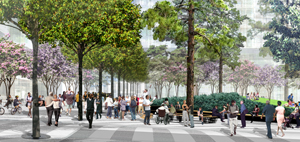Columbia University Receives First LEED-ND Certification in New York
 NEW YORK — Columbia University in New York City is making a green statement with its Manhattanville campus, as it currently earned LEED Platinum in the Neighborhood Development (ND) category of the U.S. Green Building Council’s LEED rating system. The rating makes the project the first LEED-ND Platinum certification in the state of New York.
NEW YORK — Columbia University in New York City is making a green statement with its Manhattanville campus, as it currently earned LEED Platinum in the Neighborhood Development (ND) category of the U.S. Green Building Council’s LEED rating system. The rating makes the project the first LEED-ND Platinum certification in the state of New York.
“We are proud to have earned the LEED Platinum recognition for sustainable neighborhood development,” said Columbia University president Lee C. Bollinger in a statement. “This is a milestone for Columbia, not only because we are building a future in our home community in New York, but because we are doing so with a commitment to the best urban planning principles and the highest quality architecture that reflect both the core values of city life and the fundamental need for a more sustainable society.”
The project initially began in 2006, when Peter Pitruzzello, vice president for Columbia University’s Manhattanville development group, worked with project members to actively plan for the design and construction of new buildings.
“From very early on in the project we looked at sustainability,” Pitruzzello said. “From the very first shovel full of dirt, through design and construction, and what will ultimately be the operation of the buildings, we are looking at the full-continuum of sustainability initiatives.”
 The 17-acre campus will be constructed in several phases with a slated completion date for the entire project taking 30 years. In 2007 the total project was estimated to cost $6 billion. The future campus will encompass about 6.8 million square feet, according to Pitruzzello. That includes academic buildings and academic research space, as well as university housing. It will also include a 2-acre area of open space, which will include a large square and a smaller plaza with widened sidewalks, creating a pedestrian-friendly environment.
The 17-acre campus will be constructed in several phases with a slated completion date for the entire project taking 30 years. In 2007 the total project was estimated to cost $6 billion. The future campus will encompass about 6.8 million square feet, according to Pitruzzello. That includes academic buildings and academic research space, as well as university housing. It will also include a 2-acre area of open space, which will include a large square and a smaller plaza with widened sidewalks, creating a pedestrian-friendly environment.
“We’ve started our first phase, but the project will be built in multiple phases over several decades. Construction of the first phase includes the Jerome L. Greene Science Center, the Lenfest Center for the Arts, the School of International and Public Affairs and the Columbia Business School, as well as an academic conference center, all of which will form the core of the first phase of the project” Pitruzzello said.
As time goes on other phases will be developed based upon academic need, explained Pitruzzello. The first building of Phase I, the Jerome Green Science Center, will be complete in 2016. The campus will offer public space as well as the potential for retail shops and pathways to the Hudson River waterfront.
“This is a very different kind of campus than our Morningside Heights campus. Our existing Morningside Heights campus was conceived and built over 100 years ago, and is really surrounded by gates and walls — built at a time where not much else was built around here,” Pitruzzello said. “The Manhattanville campus has many wonderful features that are open to the public, including the two public squares. There are no gates, walls or barriers, and that allows for both the university community and our neighbors to pass through freely between buildings.”
